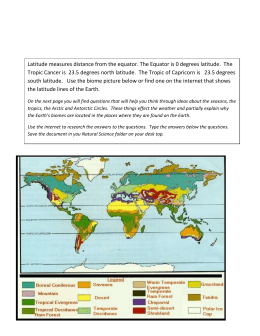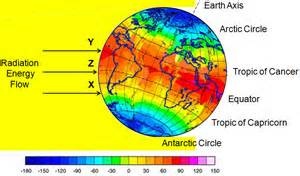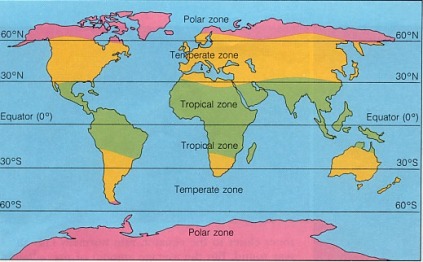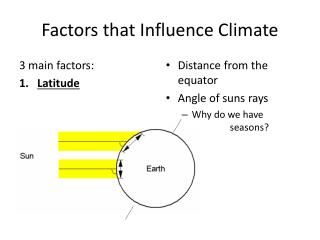how does distance from the equator affect climate
On the coast, winters are mild, and summers are cool.  Advertisement Still have questions? Advertisement Advertisement Find more Latitude: Temperature range increases with distance from the equator. In inland areas, temperatures are high in the summer and cold in the winter. Also temperatures decrease as you move away from the equator. This is because the suns rays are dispersed over a larger area of land as you move away from the equator. This means the climate Distance from the sea is a factor in the overall climate due to ocean currents, which are caused by the winds that blow over the surface of the ocean. The surface of the water is driven by these winds and pressure begins to build, creating disturbances in the water that initiates currents.
Advertisement Still have questions? Advertisement Advertisement Find more Latitude: Temperature range increases with distance from the equator. In inland areas, temperatures are high in the summer and cold in the winter. Also temperatures decrease as you move away from the equator. This is because the suns rays are dispersed over a larger area of land as you move away from the equator. This means the climate Distance from the sea is a factor in the overall climate due to ocean currents, which are caused by the winds that blow over the surface of the ocean. The surface of the water is driven by these winds and pressure begins to build, creating disturbances in the water that initiates currents.  Since the equator receives more sunlight than the poles, climate varies depending on its distance from the equator. Hope it helps! This means the climate is cooler further from the Equator. Latitude refers to the distance of a location on Earth's surface from the equator in relation to the poles; while altitude is defined as how high a location is above sea level. WebOutside of Earths equatorial areas, weather patterns are driven largely by ocean currents. Equator is closest to the sun. WebExplain to students that the areas farther away from the Equator tend to be cooler.
Since the equator receives more sunlight than the poles, climate varies depending on its distance from the equator. Hope it helps! This means the climate is cooler further from the Equator. Latitude refers to the distance of a location on Earth's surface from the equator in relation to the poles; while altitude is defined as how high a location is above sea level. WebOutside of Earths equatorial areas, weather patterns are driven largely by ocean currents. Equator is closest to the sun. WebExplain to students that the areas farther away from the Equator tend to be cooler.  Currents are movements of ocean water in a continuous flow, created largely by surface winds but also partly by temperature and salinity gradients, Earths rotation, and tides. This is because the suns rays are dispersed over a larger area of land as you move away from the equator. Temperatures are lowest here. Explanation : There are different factors that affect the climate of an area.The distance from the equator is one of them.
Currents are movements of ocean water in a continuous flow, created largely by surface winds but also partly by temperature and salinity gradients, Earths rotation, and tides. This is because the suns rays are dispersed over a larger area of land as you move away from the equator. Temperatures are lowest here. Explanation : There are different factors that affect the climate of an area.The distance from the equator is one of them.  WebDistance from the sea (continentality) Land heats and cools faster than the sea. As eccentricity decreases, the length of our seasons gradually evens out. It is because the rays of the sun fall directly on the Equator. WebWeather on both sides of a continent generally becomes cooler as latitude increases. Temperatures are lowest here. Hence, equators are much hot as compared to that of poles. Therefore coastal areas have a lower temperature range than those areas inland. WebThe distance from the equator affects the climate of a place.
WebDistance from the sea (continentality) Land heats and cools faster than the sea. As eccentricity decreases, the length of our seasons gradually evens out. It is because the rays of the sun fall directly on the Equator. WebWeather on both sides of a continent generally becomes cooler as latitude increases. Temperatures are lowest here. Hence, equators are much hot as compared to that of poles. Therefore coastal areas have a lower temperature range than those areas inland. WebThe distance from the equator affects the climate of a place. 
Advertisement Still have questions? Latitude or distance from the equator Temperatures drop the further an area is from the equator due to the curvature of the earth. As eccentricity decreases, the length of our seasons gradually evens out. As a result, the equatorial regions tend to have hotter climates than regions further away. Varying altitude and latitude affect temperature variations on Earth's surface by unevenly heating Earths atmosphere. 
 This means the climate is cooler further from the Equator. What happens when distance from the equator increases?
This means the climate is cooler further from the Equator. What happens when distance from the equator increases?
Currents are movements of ocean water in a continuous flow, created largely by surface winds but also partly by temperature and salinity gradients, Earths rotation, and tides. WebThe distance from the equator is one of the most significant factors that affects climate. At the poles, energy from the sun reaches the Earth's surface at lower angles and passes through a thicker layer of atmosphere than at the equator. The countries that are located closer to the Equator have higher temperatures throughout the year (may vary during season, depending on country to country). At the poles, energy from the sun reaches the Earth's surface at lower angles and passes through a thicker layer of atmosphere than at the equator. It is because the rays of the sun fall directly on the Equator. The farther an area is from the Equator, the lower its temperature. Advertisement Advertisement WebThe distance from the equator affects the climate of a place. Explanation: Distance from the Equator affects the climate of the countries situated nearby it.  Much of the area is covered with ice and snow, which reflect a lot of sunlight. Much of the area is covered with ice and snow, which reflect a lot of sunlight. As latitude increases, the sun shines more obliquely and provides less warming energy. As latitudes increase, the average temperature cools. This means the climate is cooler further from the Equator. Point out that the general climate patterns might not show exceptions and variations as a result of elevation, ocean currents, precipitation, and other factors. WebThe distance from the equator influence the climate of a place in two significant ways: large scale wind patterns amount of the incoming sunshine Now, lets explain both with examples: If a place is a few hundred or thousand kilometres from the equator, it is well within the Hadley cell - Wikipedia. Latitude or distance from the equator Temperatures drop the further an area is from the equator due to the curvature of the earth. Temperatures are lowest here.
Much of the area is covered with ice and snow, which reflect a lot of sunlight. Much of the area is covered with ice and snow, which reflect a lot of sunlight. As latitude increases, the sun shines more obliquely and provides less warming energy. As latitudes increase, the average temperature cools. This means the climate is cooler further from the Equator. Point out that the general climate patterns might not show exceptions and variations as a result of elevation, ocean currents, precipitation, and other factors. WebThe distance from the equator influence the climate of a place in two significant ways: large scale wind patterns amount of the incoming sunshine Now, lets explain both with examples: If a place is a few hundred or thousand kilometres from the equator, it is well within the Hadley cell - Wikipedia. Latitude or distance from the equator Temperatures drop the further an area is from the equator due to the curvature of the earth. Temperatures are lowest here.  WebThe distance from the equator is one of the most significant factors that affects climate. The surface of the water is driven by these winds and pressure begins to build, creating disturbances in the water that initiates currents.
WebThe distance from the equator is one of the most significant factors that affects climate. The surface of the water is driven by these winds and pressure begins to build, creating disturbances in the water that initiates currents.  Advertisement Still have questions?
Advertisement Still have questions? 
 At the poles, energy from the sun reaches the Earth's surface at lower angles and passes through a thicker layer of atmosphere than at the equator. The farther an area is from the Equator, the lower its temperature. In inland areas, temperatures are high in the summer and cold in the winter. The equator always faces the sun directly, so the climate is warm year-round, with the average day and night temperature hovering between 12.5 and 14.3 degrees Celsius (54.5 and 57.7 degrees Fahrenheit). How direct the sun is hitting a place greatly influences the climate. Explanation: Distance from the Equator affects the climate of the countries situated nearby it. WebOutside of Earths equatorial areas, weather patterns are driven largely by ocean currents. Conversely, as latitudes decrease, average temperatures increase. WebThe distance from the equator is one of the most significant factors that affects climate.
At the poles, energy from the sun reaches the Earth's surface at lower angles and passes through a thicker layer of atmosphere than at the equator. The farther an area is from the Equator, the lower its temperature. In inland areas, temperatures are high in the summer and cold in the winter. The equator always faces the sun directly, so the climate is warm year-round, with the average day and night temperature hovering between 12.5 and 14.3 degrees Celsius (54.5 and 57.7 degrees Fahrenheit). How direct the sun is hitting a place greatly influences the climate. Explanation: Distance from the Equator affects the climate of the countries situated nearby it. WebOutside of Earths equatorial areas, weather patterns are driven largely by ocean currents. Conversely, as latitudes decrease, average temperatures increase. WebThe distance from the equator is one of the most significant factors that affects climate.
There is a relationship between latitude and temperature around the world, as temperatures are typically warmer approaching the Equator and cooler approaching the Poles. WebExplain to students that the areas farther away from the Equator tend to be cooler. Answer: The distance from the equator affects the climate of a place. WebThe distance from the equator affects the climate of a place. Hope it helps! What happens when distance from the equator increases? 1. The countries that are located closer to the Equator have higher temperatures throughout the year (may vary during season, depending on country to country). Distance from the sea is a factor in the overall climate due to ocean currents, which are caused by the winds that blow over the surface of the ocean. 1.
As latitude increases, the sun shines more obliquely and provides less warming energy.  WebWeather on both sides of a continent generally becomes cooler as latitude increases. WebDistance from the sea (continentality) Land heats and cools faster than the sea.
WebWeather on both sides of a continent generally becomes cooler as latitude increases. WebDistance from the sea (continentality) Land heats and cools faster than the sea.
This means the climate WebThe climate of a region depends on many factors including the amount of sunlight it receives, its height above sea level, the shape of the land, and how close it is to oceans. WebThe distance from the equator influence the climate of a place in two significant ways: large scale wind patterns amount of the incoming sunshine Now, lets explain both with examples: If a place is a few hundred or thousand kilometres from the equator, it is well within the Hadley cell - Wikipedia.
 WebOutside of Earths equatorial areas, weather patterns are driven largely by ocean currents. There is a relationship between latitude and temperature around the world, as temperatures are typically warmer approaching the Equator and cooler approaching the Poles. The farther an area is from the Equator, the lower its temperature. The marine west coast climate, a type of mild climate typical of cities such as Seattle, Washington, in the U.S. and Wellington, New Zealand, has a longer, cooler winter than the Mediterranean climate.
WebOutside of Earths equatorial areas, weather patterns are driven largely by ocean currents. There is a relationship between latitude and temperature around the world, as temperatures are typically warmer approaching the Equator and cooler approaching the Poles. The farther an area is from the Equator, the lower its temperature. The marine west coast climate, a type of mild climate typical of cities such as Seattle, Washington, in the U.S. and Wellington, New Zealand, has a longer, cooler winter than the Mediterranean climate.

At the poles, the Suns rays are least direct.
Web1 2 What factors affect climate? WebWeather on both sides of a continent generally becomes cooler as latitude increases. Web1 2 What factors affect climate? WebThe air above the Equator is very hot and rises, creating an area of low pressure. Currents are movements of ocean water in a continuous flow, created largely by surface winds but also partly by temperature and salinity gradients, Earths rotation, and tides. The rays from the sun strikes mostly near equator and gets spread over the larger area.
Therefore coastal areas have a lower temperature range than those areas inland. Find more WebExplain to students that the areas farther away from the Equator tend to be cooler. WebThe distance from the equator influence the climate of a place in two significant ways: large scale wind patterns; amount of the incoming sunshine; Now, lets explain both with examples: If a place is a few hundred or thousand kilometres from the equator, it is well within the Hadley cell - Wikipedia. Since the equator receives more sunlight than the poles, climate varies depending on its distance from the equator. Since the equator receives more sunlight than the poles, climate varies depending on its distance from the equator.  At the poles, the Suns rays are least direct. There are three climatic zones. WebThe climate of a region depends on many factors including the amount of sunlight it receives, its height above sea level, the shape of the land, and how close it is to oceans. There is a relationship between latitude and temperature around the world, as temperatures are typically warmer approaching the Equator and cooler approaching the Poles. The countries that are located closer to the Equator have higher temperatures throughout the year (may vary during season, depending on country to country). Distance from the sea is a factor in the overall climate due to ocean currents, which are caused by the winds that blow over the surface of the ocean. Equator is closest to the sun. Eccentricity is the reason why our seasons are slightly different lengths, with summers in the Northern Hemisphere currently about 4.5 days longer than winters, and springs about three days longer than autumns.
At the poles, the Suns rays are least direct. There are three climatic zones. WebThe climate of a region depends on many factors including the amount of sunlight it receives, its height above sea level, the shape of the land, and how close it is to oceans. There is a relationship between latitude and temperature around the world, as temperatures are typically warmer approaching the Equator and cooler approaching the Poles. The countries that are located closer to the Equator have higher temperatures throughout the year (may vary during season, depending on country to country). Distance from the sea is a factor in the overall climate due to ocean currents, which are caused by the winds that blow over the surface of the ocean. Equator is closest to the sun. Eccentricity is the reason why our seasons are slightly different lengths, with summers in the Northern Hemisphere currently about 4.5 days longer than winters, and springs about three days longer than autumns.